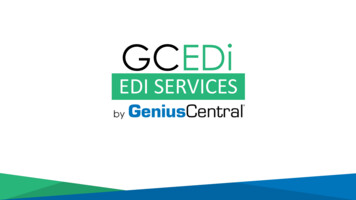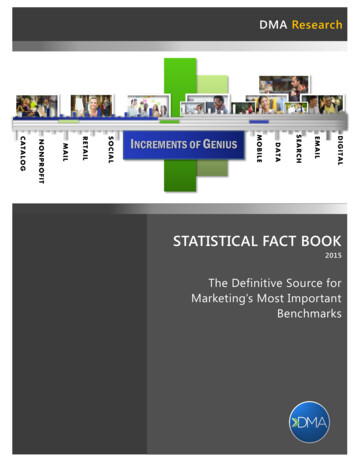
Transcription
Using the Genius Framework for Running Autonomous Negotiating PartiesT. Baarslag, W. Pasman, K. Hindriks, D. TykhonovOctober 17, 2019AbstractGenius [13] is a negotiation environment that implements an open architecture for heterogeneous negotiating parties.Genius can be used to implement, or simulate, real life negotiations. This document describes how you can install theenvironment, work with the provided scenarios and negotiation parties, and write, compile, and run an party yourself.For a quick start on how to set up your workspace with Genius we refer to Section 11.1
Contents1 Theory Crash Course1.1 Bids, Issues and Values . . . . . . . . . . . . . . . . . . .1.2 Preference Profile, Utility Space and Elicitation . . . . . .1.2.1 Utility spaces . . . . . . . . . . . . . . . . . . . . .1.2.2 Preference Uncertainty through a Partially ordered1.2.3 Elicitation through the User . . . . . . . . . . . . .1.3 Optimality of a Bid . . . . . . . . . . . . . . . . . . . . . .1.4 Negotiation Protocol . . . . . . . . . . . . . . . . . . . . .1.5 Reservation Value . . . . . . . . . . . . . . . . . . . . . .1.6 Time Pressure . . . . . . . . . . . . . . . . . . . . . . . . . . . . . . . . . .profile. . . . . . . . . . . . . . . .44445556672 Protocols2.1 Stacked Alternating Offers Protocol . . .2.2 Alternating Multiple Offers Protocol . . .2.3 Alternating Majority Consensus Protocol2.4 Simple Mediator Based Protocol . . . . .2.5 Mediator Feedback Based Protocol . . . .2.6 Beyond the Protocol . . . . . . . . . . . .77788883 Install and Run Genius3.1 Running on Hi-DPI screens . . . . . . . . . . . . . . . . . . . . . . . . . . . . . . . . . . . . . . . . . . . . .994 Scenario Creation4.1 Creating a Domain . . . . . . . . . . . . . . . . . . . . . . . . . . . . . . . . . . . . . . . . . . . . . . . . . .4.2 Creating an AdditiveUtilitySpace . . . . . . . . . . . . . . . . . . . . . . . . . . . . . . . . . . . . . . . . . .4.3 Creating an UncertainAdditiveUtilitySpace and a User . . . . . . . . . . . . . . . . . . . . . . . . . . . . . .101011115 Running Negotiations5.1 Running a Session . . . . . . . .5.2 Running a Tournament . . . . .5.2.1 Bilateral special options .5.3 Running from the command line5.3.1 Prepare the XML settings5.3.2 Run the tournament . . .5.4 Tournament Session Generation .5.4.1 Multilateral generation . .5.4.2 Bilateral generation . . . . . . .file. . . . .121213141515161616166 Quality Measures6.1 Session logs . . . . . . . . . . . . . .6.1.1 Session CSV file . . . . . . .6.1.2 Session XML file . . . . . . .6.2 Tournament logs . . . . . . . . . . .6.2.1 Tournament log.csv file . . .6.2.2 Tournament log.xml file . . .6.2.3 Tournament logStats.xml file.17171717181819197 Creating a Negotiation Party7.1 Example Parties . . . . . . . . . . . . . . . . . . . .7.2 Implementing NegotiationParty . . . . . . . . . . . .7.2.1 Receiving the Opponent’s Action . . . . . . .7.2.2 Choosing an Action . . . . . . . . . . . . . .7.3 Implementing a party with preference uncertainty . .7.3.1 Overriding functions . . . . . . . . . . . . . .7.3.2 Bid Ranking . . . . . . . . . . . . . . . . . .7.3.3 Elicitation through the User . . . . . . . . . .7.3.4 Accessing the real utility space for debugging7.3.5 Preference uncertainty agent checklist . . . .7.4 Loading a NegotiationParty . . . . . . . . . . . . . .7.5 Third party code . . . . . . . . . . . . . . . . . . . .191920212122222323232324242
8 Creating a BOA Party8.1 Components of the BOA Framework . . . . . .8.2 Create a BOA Party . . . . . . . . . . . . . . .8.3 Creating BOA Components . . . . . . . . . . .8.3.1 Set up a Workspace . . . . . . . . . . .8.3.2 Add component to Genius . . . . . . . .8.3.3 Parameters . . . . . . . . . . . . . . . .8.3.4 Creating an Offering Strategy . . . . . .8.3.5 Creating an Acceptance Condition . . .8.3.6 Creating an Opponent Model . . . . . .8.3.7 Creating an Opponent Model Strategy .8.4 Advanced: Converting a BOA Party to a Party8.5 Advanced: Multi-Acceptance Criteria (MAC) .242525262626262727272828289 Debugging299.1 Source code and javadocs . . . . . . . . . . . . . . . . . . . . . . . . . . . . . . . . . . . . . . . . . . . . . . 2910 Conclusion2911 Appendix3011.1 Connect Genius to Eclipse . . . . . . . . . . . . . . . . . . . . . . . . . . . . . . . . . . . . . . . . . . . . . . 3011.2 Insert example party . . . . . . . . . . . . . . . . . . . . . . . . . . . . . . . . . . . . . . . . . . . . . . . . . 3111.3 Debugging . . . . . . . . . . . . . . . . . . . . . . . . . . . . . . . . . . . . . . . . . . . . . . . . . . . . . . . 313
1Theory Crash CourseThis section provides a crash course on some essential theory needed to understand the negotiation system. Furthermore,it provides an overview of the features of a negotiation implemented in Genius.1.1Bids, Issues and ValuesParties participating in a negotiation interact in a domain. The domain specifies the possible bids. The parties all havetheir own preferences, which is reflected in their profile. Figure 1 shows a picture of a domain that describes the issues inthe negotiation.Figure 1: An example domain for laptop negotiation. Issues are orange, values are greenThe Domain describes which issues are the subject of the negotiation and which values an issue can attain. A domaincontains n issues: D (I1 , . . . , In ). Each issue i consists of k values: Ii (v1i , . . . , vki ). Combining these concepts, a partycan formulate a Bid : a mapping from each issue to a chosen value (denoted by c), b (vci , . . . , vcn ).To give an example, in the laptop domain the issues are “laptop”, “harddisk” and “monitor”. In this domain the issuescan only attain discrete values, e.g. the “harddisk” issue can only have the values “60Gb”, “80Gb” and “120Gb”. These issues are all instance of IssueDiscrete. A valid bid in the laptop domain is e.g. Laptop:Dell, Harddisk: 80Gb, monitor:17".A bid Laptop Asus, Harddisk: 80Gb, monitor:17" is not a valid bid because Asus is not a valid issue value in the example domain, and Laptop Asus, Harddisk: 80Gb, CPU:i7" is not valid because CPU is not an issue in this domain.1.2Preference Profile, Utility Space and ElicitationThe Preference Profile describes how bids are preferred over other bids. Typically, each participant in a negotiation hashis own preference profile. Genius supports utility spaces and partially ordered profiles.1.2.1Utility spacesOne form of profile is the UtilitySpace. The UtilitySpace specifies the preferences using an evaluator : a function that mapsbids into a real number in the range [0,1] where 0 is the minimum utility and 1 is the maximum utility of a bid. So a bidis preferred if and only if it has a higher utility than another bid.A common form of the Utility space is the Linear Additive Utility Space. This space is additive because each of theissue values in the domain have their own utility of their own, and all the sub-utilities just add up for the total utility ofthe bid. For instance, we like Apple with utility evaluation 0.7 and Dell with 0.4, completely independent of how muchmemory the computer has. Figure 2 shows a picture of a utility space for the example domain that we gave above.In an additive space the evaluator also specifies the importance of the issue relative to the other issues in the form ofa weight. The weights of all issues sum up to 1.0 to simplify calculating the utility of a bid. The utility is the weightedsum of the scaled evaluation values.U (vci , . . . , vcn ) nXi 1wieval(vci )max(eval(Ii ))(1)Other types of UtilitySpaces are the ConstraintUtilitySpace and the NonlinearUtilitySpace. These are more experimentaland not described here in more detail.4
Figure 2: An example additive utility space for the laptop domain.1.2.2Preference Uncertainty through a Partially ordered profileThe UncertainAdditiveUtilitySpace is a profile type that uses a partial ordering instead of assigning a utility value to bids.In a partial ordering, the available information is that bid X is preferred over bid Y for a subset of possible bids.An UncertainAdditiveUtilitySpace profile is generated from a AdditiveUtilitySpace as will be described in the section4, but the underlying AdditiveUtilitySpace is normally not visible for the party that uses the profile. Instead, given anUncertainAdditiveUtilitySpace, the agent’s goal is to formulate its own estimated utility function Û (ω) that approximatesthe real utility function U (ω) for every bid ω as much as possible. That is, the agent needs to find ‘the most likely’ utilityfunction from a limited ranking of outcomes.The generation of the partial ordering works as follows. The values comparisons, errors and experimental areadditional parameters of the UncertainAdditiveUtilitySpace that control the generation.1. a subset of comparisons bids are selected randomly from all possible bids.2. the selected bids are sorted in ascending utilityThis partial ordering is available to the agent through what we call a UserModel.Notice: AbstractNegotiatonParty on initialization will do a simplistic attempt to convert an UncertainAdditiveUtilitySpace into an AdditiveLinearUtilitySpace.Warning: if the number of possible bids is very large, iterating over all bids in the outcome space and sorting them canresult in running out of memory.1.2.3Elicitation through the UserIn the case where the preference profile is uncertain, the Agent might want to elicit more information about the true utilityspace in order to improve its UserModel. It is able to do so by querying the User against an elicitation cost. A User isgenerated automatically from an UncertainAdditiveUtilitySpace as will be described in section 4. To get a clearer pictureof the role of the User, one can think of it as being the personified “User” for which the agent is negotiating. The Agentcan then ask the User questions about what it wants to improve its performance, but this bothers the User to an extent.This bother is captured by the elicitation cost attributed to the User. At the end of the negotiation, the true performanceof the Agent is recorded as the User utility. It is obtained by subtracting the total bother inflicted to the User to theutility of the bid agreed upon. Namely, if ω is the agreement, then:User Utility U (ω) Total Bother Cost(2)Figure 3 presents an overview of the dynamics between the different actors involved under preference uncertainty.1.3Optimality of a BidIn general, given the set of all bids, there are a small subset of bids which are more preferred as outcomes by all partiesin the negotiation. Identifying these special bids may lead to a better agreement for both parties.5
Figure 3: Negotiation dynamics under preference uncertaintyFor a single party, the optimal bid is the bid that is most preferred / has maximum utility. Often this bid is notpreferred so much / has a low utility for other parties, and therefore the chance of agreement is low. A more general notionof optimality of a negotiation involves the utility of all parties.Figure 4: A point indicates the utility for both parties of a bid. The red line is the Pareto optimal frontier.There are multiple ways to define a more global “optimum”. One approach to optimality is that a bid is not optimalfor both parties if there is another bid that has the higher utility for one party, and at least equal utility for the otherparty. Thus, only bids in Figure 4 for which there is no other bid at the top right is optimal. This type of optimality iscalled Pareto optimality and forms an important concept in automated negotiation. The collection of Pareto optimal bidsis called the Pareto optimal frontier.A major challenge in a negotiation is that parties can hide their preferences. This entails that an party does not knowwhich bid the opponent prefers given a set of bids. This problem can be partly resolved by building an opponent modelof the opponent’s preferences by analyzing the negotiation trace. Each turn the party can now offer the best bid for theopponent given a set of similar preferred bids. Genius provides a number of components that can estimate an opponentmodel.1.4Negotiation ProtocolThe negotiation protocol determines the overall order of actions during a negotiation. Parties are obliged to stick tothis protocol, as deviations from the protocol are caught and penalized. Genius supports multiple protocols. These arediscussed in detail in section 2.1.5Reservation ValueA reservation value is a real-valued constant that sets a threshold below which a rational party should not accept any offers.Intuitively, a reservation value is the utility associated with the Best Alternative to a Negotiated Agreement (BATNA).6
A reservation value is the minimum acceptable utility, offers with a utility would normally not be accepted by a party.Reservation values typically differ for each negotiation party. In case no reservation value is set in a profile, it is assumed tobe 0. Notice that if a negotiation ends with no agreement, parties normally get a utility of 0, regardless of the reservationvalue.1.6Time PressureA negotiation lasts a predefined time in seconds, or alternatively rounds. In Genius the time line is normalized, i.e.: timet [0, 1], where t 0 represents the start of the negotiation and t 1 represents the deadline. Notice that manipulationof the remaining time can be a factor influencing the outcome.There is an important difference between a time-based and rounds-based protocol. In a time-based protocol thecomputational cost of an party should be taken into account as it directly influences the amount of bids which canbe made. In contrast, for a rounds-based negotiation the time can be thought of as paused within a round; thereforecomputational cost does not play a role.Apart from a deadline, a scenario may also feature discount factors. Discount factors decrease the utility of the bidsunder negotiation as time passes. While time is shared between both parties, the discount generally differs per party.The default implementation of discount factors is as follows: let d in [0, 1] be the discount factor that is specified in thepreference profile of a party; let t in [0, 1] be the current normalized time, as defined by the timeline; we compute thetdiscounted utility UDof an outcome ω from the undiscounted utility function U as follows:tUD(ω) U (ω) · dt(3)If d 1, the utility is not affected by time, and such a scenario is considered to be undiscounted, while if d is very smallthere is high pressure on the parties to reach an agreement. Note that discount factors are part of the preference profilesand therefore different parties may have a different discount factor.If a discount factor is present, reservation values will be discounted in exactly the same way as the utility of any otheroutcome. It is worth noting that, by having a discounted reservation value, it may be rational for parties to end thenegotiation early and thereby default to the reservation value.Note: time pressure has little meaning if the profile is not defined in terms of utilities, eg a partially ordered profile.2ProtocolsThis section describes the various negotiation protocols. The protocol determines the overall order of actions during anegotiation. This section focuses on the MultiParty protocols as these have been properly developed. There is also aprotocol class for the bilateral negotiation, but this is basically a hard coded Stacked Alternating Offers Protocol and notfurther developed.The (Multilateral) protocol describes if the negotiation is finished, what the agreement is, which actions can be donein the next round. Briefly, to run a session the system checks with the protocol if the negotiation is already finished,and if not which calls need to be made to the parties (both chooseAction and receiveMessage). We recommend checkingthe javadoc of MultilateralProtocol for up-to-date detail information and how the protocol is used by the system to runsessions.The Multilateral protocol uses the notion of rounds and turns to describe the negotiation layout. A round is a part ofthe negotiation where all participants get a turn to respond to the current state of the negotiation. A turn refers to theopportunity of one party to make a response to the current state of the negotiation.If a party violates the protocol – for instance by sending an action that is not one of the allowed ones, or by crashing,the negotiation ends and the outcome usually is ’no agreement’ for all parties. In bilateral negotiation we have a specialcase then: the party’s utility is set to its reservation value, whereas the opponent is awarded the utility of the last offer.All protocols are found in the package genius.core.protocol and have the names matching the subsections below.2.1Stacked Alternating Offers ProtocolAccording to this protocol [1] , all of the participants around the table get a turn per round. Turns are taken clockwise around the table. One of the negotiating parties starts the negotiation with an offer that is observed by all othersimmediately. Whenever an offer is made, the next party in line gets a call to receiveMessage containing the bid, followedby a call to chooseAction from which it can return the following actions: Accept the offer (not available the very first turn). send an Offer to make a counter offer (thus rejecting and overriding the previous offer, if there was any) send an EndNegotiation and ending the negotiation without any agreement.This protocol is the default protocol for Parties (as returned by getProtocol()).2.2Alternating Multiple Offers ProtocolAccording to this protocol [1], all parties have a bid from all parties available to them, before they vote on these bids.This implemented in the following way: The protocol has a bidding phase followed by voting phases. In the bidding phaseall participants put their offer on the table. These offers appear to all parties through receiveMessage() in a specific order.7
In the voting phases all participants vote on all of the bids on the negotiation table, in the same order as received. Foreach offer, the party’s chooseAction() is called. If one of the bids on the negotiation table is accepted by all of the parties,then the negotiation ends with this bid.In each even round (we start in round 0), each party gets only one turn for an OfferForVoting.In each odd round there are N voting turns for each party (N being the number of offers), one for each offer in orderof reception. these are the available options: Accept the offer Reject the offer2.3Alternating Majority Consensus ProtocolThis protocol is essentially equal to the Alternating Multiple Offers Protocol, but now an offer the protocol keeps trackof the acceptable offer that got most accepts. Initially, this may be the first offer that got one accept. After a number ofrounds, some offers receive multiple accepts and these then become the new acceptable offer.If an offer is accepted by all parties, the negotiation ends. Otherwise, the negotiation continues (unless the deadline isreached). If the deadline is reached, the acceptable offer becomes the agreement.2.4Simple Mediator Based ProtocolIn this protocol, the parties do not hear the other parties directly. Instead, they only hear the mediator and the mediatorhears the bids of all the parties. The mediator determines which bid will be voted on, collects the votes and determinesthe outcome. The mediator is just another NegotiationParty, but it extends Mediator.The protocol requires that exactly one party is a Mediator. The Genius GUI enforces this presence of a Mediator.When you run a negotiation from the command line you have to ensure the presence of a single Mediator.This protocol uses the following turns in every round:1. Mediator proposes an OfferForVoting2. The other parties (not the mediator) place a VoteForOfferAcceptance on the OfferForVoting3. The mediator makes a InformVotingResult that informs all parties about the outcome of this round.With this protocol, the last InformVotingResult with an accept determines the current outcome.As mentioned, you have to provide one mediator. There is the following options RandomFlippingMediator. This mediator generates random bids until all parties accept. Then, it randomly flips oneissue of the current offer to generate a new offer. It keeps going until the deadline is reached. FixedOrderFlippingMediator. This mediator behaves exactly like the RandomFlippingMediator, except that it usesa fixed-seed Random generator for every run. This makes it easier for testing.2.5Mediator Feedback Based ProtocolLike the Simple Mediator Based Protocol, the parties do not hear the other parties directly. Instead, they only hear themediator and the mediator hears the bids of all the parties. The mediator determines which bid will be voted on, collectsthe votes and determines the outcome. The mediator is just another NegotiationParty, but it extends Mediator.The mediator generates its first bid randomly and sends it to the negotiating parties. After each bid, each partycompares the mediator's new bid with his previous bid and gives feedback (‘better’, ‘worse’ or ‘same’) to the mediator.For its further bids, the mediator updates the previous bid, hopefully working towards some optimum. The negotiationruns on until the deadline (unless some party crashes). This protocol is explained in detail in [2].This protocol uses the following turns in every round:1. Mediator proposes an OfferForFeedback.2. The other parties (not the mediator) place a GiveFeedback, indicateing whether the last bid placed by the mediatoris better or worse than the previous bid.The accepted bid is the last bid that was not receiving a ‘worse’ vote.2.6Beyond the ProtocolThis section outlines the procedures for the parts of the session outside the scope of the protocol specification.Before the protocol can be started, the parties have to be loaded and initialized. During initialization, the party’spersistent data may have to be loaded from a file. If the persistent data can not be read, a default empty dataset is createdfor the party. Then the party’s init code is called to set up the party. All the time spent in this initialization phase isalready being subtracted from the total available negotiation time.After the protocol has been completed, the protocol is called a last time to determine the final outcome. The partiesare called to inform them that the negotiation ended, and what the outcome was. This happens even when parties crashedor did illegal actions. The negotiation has already finished, so these calls are not weighing in on the total negotiation time.Instead, these calls are typically limited to 1 second.Finally, if the party has modified the persistent data, this data needs to be saved. Again, this action is limited to a 1second duration.8
Errors surrounding these out-of-protocol procedures are not part of the negotiation itself and therefore logged andhandled separately. These errors are printed only to the console/terminal 1 , and only from the single session runner.3Install and Run GeniusGenius can run on any machine running Java 8. Java 9 is not yet supported. Please report any bugs found to negotiation@ii.tudelft.nl.To install the environment, the file genius-XXX.zip can be downloaded from http://ii.tudelft.nl/genius/?q article/releases. Unzip the file at a convenient location on your machine. This will result in a folder “genius-XXX”containing the following files: a userguide.pdf which is this document. genius-XXX.jar, the Genius negotiation simulator; a few example folders, containing ready-to-compile parties and components. a multilateraltournament.xml example fileYou start Genius by double-clicking the genius-XXX.jar file, or using ”open with” and then selecting Java.After starting the simulator a screen similar to Figure 5 is shown. This screen is divided in three portions: The Menubar allows us to start a new negotiation. The Components Window shows all available scenarios, parties, and BOA components. The Status Window shows the negotiation status or selected domain/preference profile.Figure 5: Genius right after start-up. The left half is the components panel, the right half the status panel.Progress messages and error messages are printed mainly to the standard output. On Mac OSX you can view thesemessages by opening the console window (double-click on Systemdisk/Applications/Utilities/Console.app). On Windowsthis is not directly possible. Console output can be read only if you start the application from the console window byhand, as follows. Go to the directory with the genius-XXX.jar and enter java -jar genius-XXX.jar. This will start thesimulator, and all messages will appear in the console window. You may see some errors and warnings that are non-critical.In some rare cases, parties and scenarios require more memory than allocated by default to Java. This problem canbe resolved by using the Xmx and Xms parameters when launching the executable jar, for example java -Xmx1536M-Xms1536M -jar genius-XXX.jar. But usually, if your party runs out of memory then there is some design flaw or bug.Competitions usually are run with the default amount of java memory so it is recommended to ensure that your partyperforms properly without requiring additional memory.Please refer to chapter 9 for instructions on running Genius in debug mode to debug your party.3.1Running on Hi-DPI screensThere is a bug in Java 8 that prevents windows from scaling up the Genius application windows on hi-dpi screens. Thebug is that Java 8 tells Windows that it will do the up-scaling itself, while java actually does not scale up anything. Tofix this, do the following:Find java.exe and javaw.exe that are used for running Genius (Double check if you have installed multiple versionsof Java). Usually they are somewhere below C:\Program Files\Java\jre\bin or similar. For both applications, do this:1. Right click on the icon and select Properties2. Go to Compatibility tab3. Check ”Override high DPI scaling behavior”.4. Scaling performed by: set to ”System”1 Tosee the console output, run from Eclipse or start up Genius from a separate terminal.9
4Scenario CreationGenius offers tools to create Domains and Profiles. Currently Genius supports editing the Additive and the UncertainAdditive utility space This section discusses how to create domains and preference profiles.4.1Creating a DomainBy right clicking on the list of available scenarios in the Domains panel a popup menu with the option to create a newdomain is shown. After clicking this option a pop-up appears requesting the name for the new domain. After you enter aname and click ok, the new domain is created and a window similar to Figure 6 is shown. Initially, a domain contains zeroissues. We can simply add an issue by pressing the “Add issue” button. This results in the opening of a dialog similar toFigure 7.Figure 6: Genius after creating a new Example domain.The current version of Genius supports the creation of discrete and integer issues. Starting with a discrete issue, thevalues of the issue should be specified. In Figure 7 we show the values of the issue “Harddisk”. Note the empty evaluationvalues window, later on when creating a preference profile we will use this tab to specify the preference of each value.Instead of a discrete issue, we can also add an integer issue as shown in Figure 8. For an integer issue we first need tospecify the lowest possible value and the highest value, for example the price range for a second hand car may be [500, 700].Next, when creating a preference profile we need to specify the utility of the lowest possible value (500) and the highestvalue (700). During the negotiation we can offer any value for the issue within the specified range.The next step is to press “Ok” to add the issue. Generally, a domain consists of multiple issues. We can simply addthe other issues by repeating the process above. If you are satisfied with the domain, you can save it by pressing “Savechanges”.Finally, note that
Genius [13] is a negotiation environment that implements an open architecture for heterogeneous negotiating parties. Genius can be used to implement, or simulate, real life negotiations. This document describes how you can install the environment, work with the provided scenarios and negotiation










